#cloud migration AWS
Explore tagged Tumblr posts
Text
Accelerating transformation: The impact of automation on cloud migration

Cloud computing has become the bedrock of modern businesses. The ability to store, manage, and access data and applications remotely has revolutionized the way organizations operate. However, the journey to migration of an organization’s digital assets, applications, data, and workloads from conventional on-premises infrastructure to cloud-based platforms isn’t always straightforward.
Cloud migration involves meticulous planning, resource allocation, and implementation strategies. This is where automation plays a pivotal role in accelerating the process.
Gartner predicts 60% of data center infrastructure teams will have relevant automation and cloud skills by 2027
In this blog we will explore the profound implications of automation in accelerating the rapid migration to cloud infrastructure.
Benefits of automated cloud migration
Due to the rising complexities in the migration process, leveraging automation becomes paramount. By integrating automated tools and methodologies, organizations can streamline their migration projects, achieving faster, more accurate, and reliable outcomes. Here are some key benefits:
1. Efficiency improvements
Automation streamlines tasks, optimizing processes and resource utilization for faster completion during cloud migration. By eliminating manual intervention, organizations can achieve greater efficiency and reduce the time required for migration.
2. Cost savings
One of the significant advantages of automation in cloud migration is the reduction of operational costs. By minimizing manual intervention and enhancing resource efficiency, organizations can achieve cost savings throughout the migration process.
3. Reduction in manual errors
Human errors can have significant consequences during cloud migration, leading to data loss or application failures. Automation reduces the likelihood of manual errors, ensuring the secure and accurate transfer of data and applications to the cloud environment.
4. Accelerated deployment cycles
Automated procedures expedite the deployment of applications and resources, significantly reducing deployment time. This allows organizations to take advantage of the scalability and flexibility offered by the cloud, enabling faster time-to-market for new products and services.
5. Scalability and flexibility
Automation enables easy scaling and swift adaptation to changing needs during cloud migration. Organizations can effortlessly adjust their resources and infrastructure to accommodate growth and changing requirements, ensuring a seamless transition to the cloud.
Tools and technologies for automating cloud migration processes
Several tools and technologies can facilitate the automation of cloud migration processes. Here are some popular ones:
1. Infrastructure as Code (IaC) tools
Infrastructure as Code (IaC) tools enable organizations to automate infrastructure provisioning and configuration management. Some widely used IaC tools include:
Terraform: Empowers infrastructure automation through declarative configuration files.
AWS CloudFormation: Simplifies the provisioning of AWS resources using templates.
Azure Resource Manager: Offers templates for resource deployment in Azure.
2. Data migration tools
Data migration is a critical aspect of cloud migration, and several tools are available to facilitate seamless data transfer. Some commonly used data migration tools include:
AWS Database Migration Service: Facilitates the migration of databases to AWS with minimal downtime.
Azure Database Migration Service: Enables organizations to migrate databases to Azure with ease.
Google Cloud Data Transfer Service: Streamlines the process of transferring data to Google Cloud.
3. CI/CD tools
Continuous integration and continuous deployment (CI/CD) tools automate the software development process, allowing for efficient application deployment and management. Here are some popular CI/CD tools:
Jenkins: An open-source automation server for continuous integration and delivery.
GitLab CI/CD: Provides a robust platform for the entire DevOps lifecycle.
CircleCI: Offers cloud-based CI/CD for automating the software development process.
Key areas for automation in cloud migration
1. Resource provisioning and configuration
Automating resource provisioning and configuration management is crucial for optimizing cloud migration. By implementing automated procedures, organizations can ensure efficient resource utilization and streamlined configurations.
2. Data migration and transfer
Smooth data migration and synchronization are vital for a successful cloud migration strategy. Automated tools facilitate secure and accurate data transfer, ensuring that vital data is seamlessly moved to the cloud environment.
3. Application deployment and management
Efficient application deployment and management are essential for leveraging the benefits of the cloud. By integrating CI/CD pipelines and containerization tools, organizations can automate application deployment, accelerating deployment cycles and ensuring effective management in the cloud.
Best practices for implementing automation in cloud migration
1. Assessment and planning
Evaluate the current state of infrastructure, applications, dependencies, and interconnections.
Clearly define objectives and expected outcomes from the migration.
Utilize automated assessment tools to identify workloads suitable for migration.
Select the right automation tools and frameworks based on compatibility and requirements.
2. Standardization and templates
Standardize configurations by creating templates and standard configurations.
Develop reusable automation scripts or playbooks for consistent deployment across different environments.
3. Security and compliance
Implement automated security checks and configurations to ensure compliance adherence.
Utilize identity and access management automation for secure resource access.
4. Testing and validation
Implement automated testing for applications to ensure they function properly in the cloud environment.
Develop validation procedures and automated tests to confirm successful migrations.
5. Incremental migration and monitoring
Break down the migration into smaller, manageable chunks to reduce risks and enable iterative improvements.
Implement automated monitoring tools to track performance, detect issues, and optimize resource usage post-migration.
How to identify if automated cloud migration works for your business?
Discovering if automated cloud migration suits your business involves diving into crucial factors. It’s like finding the perfect puzzle piece that fits seamlessly. To unravel this puzzle, peek into your business’s needs, goals, and capabilities, consider the following factors:
Assess your business objectives and evaluate how automation can support them.
Evaluate the complexity and scale of your migration project and determine if automation can streamline the process.
Conduct a risk assessment to identify potential challenges and determine if automation can mitigate them.
Consider the time-to-value and speed of deployment that automation can offer.
Assess the scalability and flexibility that automation can provide to accommodate your business’s future growth.
Evaluate the compatibility of your applications with automation tools and frameworks.
Consider conducting pilot projects or proof of concepts to test the feasibility and effectiveness of automated cloud migration for your business.
Embrace automated cloud migration for hassle-free transformation
Adopting automation isn’t merely an enhancement but a necessity in modernizing infrastructure. It empowers businesses to concentrate on innovation, secure in the knowledge that the foundation of their operations is well-optimized and future-ready.
Are you looking to seamlessly transition your operations to the cloud? Our automated cloud migration services are designed to simplify and expedite the migration process for your business. With our expertise in cloud consulting services, we ensure a smooth transition, optimizing efficiency and minimize disruptions. Excited to tap into the perks of automated cloud migration? Let’s make your transformation effortless starting today.
#Cloud Migration Service#cloud migration AWS#Cloud Automation#Cloud Migration Strategies#Cloud consulting services
0 notes
Text
Journey to Devops
The concept of “DevOps” has been gaining traction in the IT sector for a couple of years. It involves promoting teamwork and interaction, between software developers and IT operations groups to enhance the speed and reliability of software delivery. This strategy has become widely accepted as companies strive to provide software to meet customer needs and maintain an edge, in the industry. In this article we will explore the elements of becoming a DevOps Engineer.
Step 1: Get familiar with the basics of Software Development and IT Operations:
In order to pursue a career as a DevOps Engineer it is crucial to possess a grasp of software development and IT operations. Familiarity with programming languages like Python, Java, Ruby or PHP is essential. Additionally, having knowledge about operating systems, databases and networking is vital.
Step 2: Learn the principles of DevOps:
It is crucial to comprehend and apply the principles of DevOps. Automation, continuous integration, continuous deployment and continuous monitoring are aspects that need to be understood and implemented. It is vital to learn how these principles function and how to carry them out efficiently.
Step 3: Familiarize yourself with the DevOps toolchain:
Git: Git, a distributed version control system is extensively utilized by DevOps teams, for code repository management. It aids in monitoring code alterations facilitating collaboration, among team members and preserving a record of modifications made to the codebase.
Ansible: Ansible is an open source tool used for managing configurations deploying applications and automating tasks. It simplifies infrastructure management. Saves time when performing tasks.
Docker: Docker, on the other hand is a platform for containerization that allows DevOps engineers to bundle applications and dependencies into containers. This ensures consistency and compatibility across environments from development, to production.
Kubernetes: Kubernetes is an open-source container orchestration platform that helps manage and scale containers. It helps automate the deployment, scaling, and management of applications and micro-services.
Jenkins: Jenkins is an open-source automation server that helps automate the process of building, testing, and deploying software. It helps to automate repetitive tasks and improve the speed and efficiency of the software delivery process.
Nagios: Nagios is an open-source monitoring tool that helps us monitor the health and performance of our IT infrastructure. It also helps us to identify and resolve issues in real-time and ensure the high availability and reliability of IT systems as well.
Terraform: Terraform is an infrastructure as code (IAC) tool that helps manage and provision IT infrastructure. It helps us automate the process of provisioning and configuring IT resources and ensures consistency between development and production environments.
Step 4: Gain practical experience:
The best way to gain practical experience is by working on real projects and bootcamps. You can start by contributing to open-source projects or participating in coding challenges and hackathons. You can also attend workshops and online courses to improve your skills.
Step 5: Get certified:
Getting certified in DevOps can help you stand out from the crowd and showcase your expertise to various people. Some of the most popular certifications are:
Certified Kubernetes Administrator (CKA)
AWS Certified DevOps Engineer
Microsoft Certified: Azure DevOps Engineer Expert
AWS Certified Cloud Practitioner
Step 6: Build a strong professional network:
Networking is one of the most important parts of becoming a DevOps Engineer. You can join online communities, attend conferences, join webinars and connect with other professionals in the field. This will help you stay up-to-date with the latest developments and also help you find job opportunities and success.
Conclusion:
You can start your journey towards a successful career in DevOps. The most important thing is to be passionate about your work and continuously learn and improve your skills. With the right skills, experience, and network, you can achieve great success in this field and earn valuable experience.
2 notes
·
View notes
Text

The finance sector has to follow stringent compliance and regulatory requirements. This makes data security a very important consideration.
With ITTStar’s VDI solution, your financial data stays secure, centralized, and accessible only by authorized personnel. All user activity is monitored and logged to ensure compliance with industry standards. VDI allows financial institutions to simplify their compliance efforts by controlling access to sensitive financial data.
ITTStar’s VDI can help you stay secure and compliant in the finance industry today. Connect with us to find out how!
#vdi#vdifinance#vdisolutions#vdimanagedservices#cloudsecurity#ittstar#aws services#cloud services#cloud migration
0 notes
Text
Top 7 AWS Migration Strategies for a Seamless Cloud Transformation
0 notes
Text
Cloud Migration Made Easy with Simple Logic☁️
🔄 Risk Free Data Transfer
Migrate workloads with zero downtime
🌍 Multi Cloud & Hybrid Support
Seamless integration across AWS, Azure, and GCP
🔒 Security First Approach
Ensure compliance and data protection during migration
💰 Cost Optimization Strategies
Maximize cloud efficiency while minimizing expenses
Simplify Your Cloud Journey Today✨
📧 Email: [email protected]
📞 Phone: +91 86556 16540
To know more about Cloud Migration click here 👉 https://simplelogic-it.com/cloud-migration/
Visit our website 👉 https://simplelogic-it.com/
💻 Explore insights on the latest in #technology on our Blog Page 👉 https://simplelogic-it.com/blogs/
🚀 Ready for your next career move? Check out our #careers page for exciting opportunities 👉 https://simplelogic-it.com/careers/
#CloudMigration#DataTransfer#HybridSupport#AWS#Azure#Migration#CostOptimization#CloudEfficiency#Cloud#CloudService#SimpleLogicIT#MakingITSimple#MakeITSimple#SimpleLogic
0 notes
Text

Best amazon cloud computing | Fastcurve
Fastcurve is your partner of choice for Amazon cloud computing solutions that will drive operational excellence and innovation. They understand the important role a strong cloud strategy can have, and their team is here to simplify your journey with AWS. Through the innovative implementation of cloud solutions tailored to your specific business needs, they empower you to scale effectively while enhancing security and optimizing costs. Rely on Fastcurve to equip your organization with the tools and expertise necessary to thrive in today’s digital landscape.
0 notes
Text
#AWS to Azure Migration#Cloud Migration Strategies#Azure Migration Tools#Cloud Computing#DevOps#Cloud Cost Optimization
0 notes
Text
New to cloud migration? Learn the essentials of AWS data migration services needed in 2024 and find the best migration solution for your business.
For more information visit: https://www.augmentedtechlabs.com/blog/how-to-choose-aws-data-migration-service
0 notes
Text
When re-building your application, Which option do you have that gives optimum performance in Cloud?
#technology#automation#aws cloud#gitlab#aws#google cloud#microsoft azure#startup#cloud migration#cloud services#cloud service provider#cloud security#startups#devops#devopsengineer#devsecops
0 notes
Text
AWS Cloud Migration: Benefits, Strategies, and Phases Simplified

Many businesses embark on their cloud migration journey with a strategy known as “lift and shift.” This approach involves relocating existing applications from on-premises environments to the cloud without altering their architecture. It’s an efficient and straightforward starting point, often appealing due to its simplicity and speed.
However, as companies dive deeper into the cloud ecosystem, they uncover a broader spectrum of possibilities. Lift and shift, though effective initially, is only the foundation of cloud migration. Businesses quickly realize that cloud computing offers far more than just infrastructure relocation.
To unlock its true potential, modernization becomes essential. Modernization transforms applications to align with cloud-native architectures. This ensures businesses can harness advanced features like scalability, resilience, and cost efficiency. It’s no longer about merely shifting workloads; it’s about reimagining them for the future.
This evolution in approach is also reflected in the market’s staggering growth. According to Gartner, Inc., global end-user spending on public cloud services is projected to grow by 20.4% in 2024, reaching $675.4 billion from $561 billion in 2023. Generative AI (GenAI) and application modernization are major drivers of this surge. This data underscores the strategic importance of not just migrating to the cloud but modernizing applications to stay competitive in an evolving landscape.
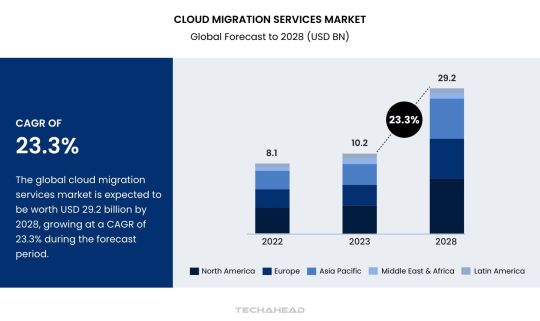
For instance, early adopters of cloud migration often struggled with limited performance gains post-migration. They soon discovered that while lift and shift addressed immediate needs, it didn’t optimize long-term efficiency. Modernization solved this challenge by enabling applications to utilize the dynamic capabilities of cloud platforms.
This shift in approach isn’t just about technology—it’s about competitiveness. Businesses that embrace modernization gain agility and faster time-to-market, giving them a significant edge. They leverage tools like containerization and serverless computing, allowing seamless adaptation to evolving customer demands.
In this blog, we’ll delve into the reasons why lift and shift is just the starting line. We’ll also explore how modernization drives real value and share best practices for ensuring a smooth transition. By the end, you’ll understand why adapting to the evolving cloud landscape is not just a choice—it’s a necessity.
Benefits of AWS Migration
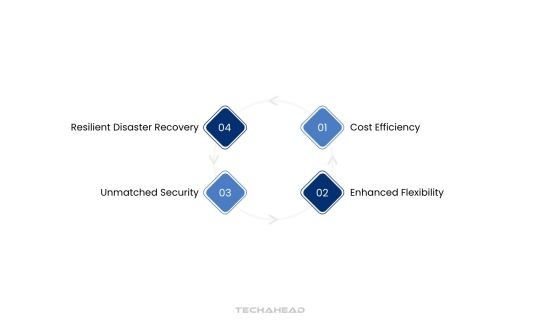
Transitioning your cloud infrastructure to the AWS cloud unlocks unparalleled scalability and efficiency. AWS provides a suite of advanced computing resources tailored to manage IT operations seamlessly. This enables your business to channel its efforts, resources, and investments into core activities that drive growth and profitability.
By adopting AWS cloud infrastructure, you eliminate the constraints of physical data centers and gain unrestricted, anytime-anywhere access to your data. Global giants like Netflix, Facebook and the BBC leverage AWS for its unmatched reliability and innovation. Let’s explore how AWS helps streamline IT operations while ensuring cost-effectiveness and agility.
Cost Efficiency
Expanding cloud infrastructure typically requires significant investment in hardware and administrative overhead. AWS eliminates these costs with a pay-as-you-go model.
Zero Upfront Investment: Run enterprise applications and systems without the need for large initial capital.
Flexible Scaling: AWS enables businesses to upscale or downscale resources instantly, ensuring that you never pay for unused capacity. This dynamic scaling matches your operational demands and avoids the waste associated with overprovisioning.
Advanced Cost Control: AWS provides tools like Cost Explorer and AWS Budgets, helping businesses track, forecast, and optimize cloud expenses. By analyzing consumption patterns, organizations can minimize waste and ensure maximum return on investment (ROI).
Reduced Maintenance Overheads: Without the need to maintain physical servers, businesses save on administrative and repair costs, redirecting budgets to strategic growth areas.
Enhanced Flexibility
AWS offers unparalleled adaptability, making it suitable for businesses of all sizes, whether they are start-ups, enterprises, or global businesses. Its integration capabilities enable smooth migrations and rapid scaling.
Seamless Compatibility: AWS supports a vast number of programming languages, operating systems, and database types. This ensures that existing applications or software frameworks can integrate effortlessly, eliminating time-consuming reconfigurations.
Rapid Provisioning of Resources: Whether migrating applications, launching new services, or preparing for DevOps, AWS provides the agility to provision resources instantly. For instance, during seasonal demand spikes, businesses can quickly allocate additional capacity and scale back during off-peak times.
Developer Productivity: Developers save time as they don’t need to rewrite codebases or adopt new frameworks. This allows them to focus on building innovative applications rather than troubleshooting compatibility issues.
Unmatched Security
Security is a cornerstone of AWS’s offerings, ensuring that your data remains protected against internal and external threats. AWS combines global infrastructure standards with customizable tools to meet unique security needs.
Shared Responsibility Model: AWS takes care of the underlying infrastructure, including physical security and global compliance. Customers are responsible for managing access, configuring permissions, and securing their data.
Data Encryption: AWS allows businesses to encrypt data both at rest and in transit, ensuring end-to-end protection. Businesses can leverage services like AWS Key Management Service (KMS) for robust encryption.
Compliance and Governance: AWS adheres to internationally recognized standards, including ISO 27001, GDPR, and SOC. This helps businesses meet legal and regulatory requirements with ease.
Threat Mitigation: AWS offers tools like AWS Shield and GuardDuty to detect and mitigate cybersecurity threats in real time, providing peace of mind in a rapidly evolving threat landscape.
Resilient Disaster Recovery
Disruption like power outages, data corruption, or natural disasters can cripple traditional IT systems. AWS AWS equips businesses with robust disaster recovery solutions to maintain operational continuity.
Automated Recovery Processes: AWS simplified disaster recovery through services like AWS Elastic Disaster Recovery, which automates recovery workflows and reduces downtime significantly.
Global Redundancy: Data is stored across multiple geographic locations, ensuring that even if one region experiences issues, operations can seamlessly shift to another. This minimizes disruptions and maintains business continuity.
Cost-Efficient Solutions: Unlike traditional disaster recovery setups that duplicate hardware, AWS’s cloud-based approach uses on-demand resources. This reduces capital investments while delivering the same level of protection.
Faster Recovery Times: With AWS, businesses can restore systems and data within minutes, ensuring minimal impact on operations and customer experiences.
Cloud migration with AWS is more than just a technological upgrade; it’s a strategic move that empowers businesses to innovate, scale, and thrive in a competitive market. By leveraging AWS, organizations can reduce costs, enhance flexibility, strengthen security, and ensure resilience.
7 Cloud Migration Strategies for AWS
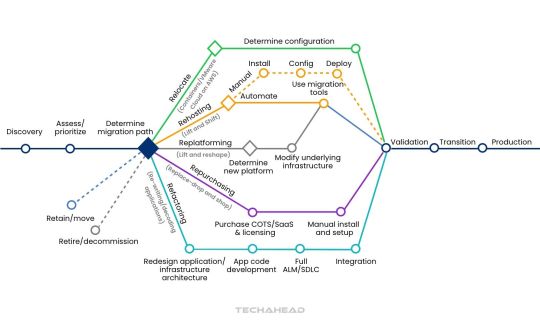
AWS’s updated 7 Rs model for cloud migration builds on Gartner’s original 5 Rs framework. Each strategy caters to unique workloads and business needs, offering a tailored approach for moving to the cloud. Let’s explore these strategies in detail.
Rehost (Lift and Shift)
The rehost strategy involves moving workloads to the cloud with minimal changes using Infrastructure-as-a-Service (IaaS). Enterprises migrate applications and dependencies as they are, retaining the existing configurations. This approach ensures operational consistency and reduces downtime during migration. It is an easy-to-perform option, especially for businesses with limited in-house cloud expertise. Additionally, rehosting helps businesses avoid extensive re-architecting, making it a cost-effective and efficient solution.
Relocate (Hypervision-Level Lift and Shift)
Relocating shifts workloads to a cloud-based platform without altering source code or disrupting ongoing operations. Organizations can transition from on-premises platforms like VMware to cloud services such as Amazon Elastic Kubernetes Service (EKS). This strategy minimizes downtime and ensures seamless business operations during migration. Relocating maintains existing configurations, eliminating the need for staff retraining or new hardware. It also offers predictable migration costs, with clear scalability limits to control expenses.
Replatform (Lift and Reshape)
The replatform approach optimizes workloads by introducing cloud-native features while maintaining the core application architecture. Applications are modernized to leverage automation, scalability, and cloud compliance without rewriting the source code. This strategy enhances resilience and flexibility while preserving legacy functionality. Partial modernization reduces migration costs and time while ensuring minimal disruptions. Teams can manage re-platformed workloads with ease since the fundamental application structure remains intact.
Refactor (Re-architect)
Refactoring involves redesigning workloads from scratch to utilize cloud-native technologies and features fully. This strategy supports advanced capabilities like serverless computing, autoscaling, and enhanced automation.
Refactored workloads are highly scalable and can adapt to changing demands efficiently. Applications are often broken into microservices, improving availability and operational efficiency. Although refactoring requires significant initial investment, it reduces long-term operational costs by optimizing the cloud framework.
Repurchase (Drop and Shop)
Repurchasing replaces existing systems with third-party solutions available on the cloud marketplace. Organizations adopt a Software-as-a-Service (SaaS) model, eliminating the need for infrastructure management. This approach reduces operational efforts and simplifies regulatory compliance, ensuring efficient governance. Repurchasing aligns IT costs with revenue through consumption-based pricing models. It also accelerates migration timelines, enhancing user experience and performance with minimal downtime.
Retire
The retirement strategy focuses on decommissioning applications that no longer hold business value. Inefficient legacy systems are terminated or downsized to free up resources for more critical functions. Retiring outdated workloads reduces operational costs and simplifies IT management. This strategy also allows businesses to streamline their application portfolio, focusing efforts on modernizing essential systems.
Retain (Revisit)
The retain strategy is used for applications that cannot yet be migrated to the cloud. Some workloads rely on systems that need to be transitioned first, making retention a temporary solution. Businesses may also retain applications while waiting for SaaS versions from third-party providers. Retaining workloads provides flexibility, allowing organizations to revisit migration strategies and align them with long-term objectives.
Cloud Transformation Phases
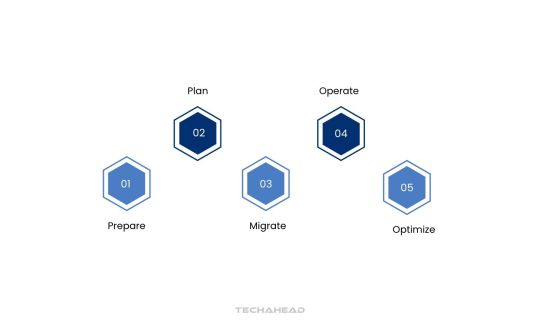
Cloud transformation is a comprehensive process where businesses transition from traditional IT infrastructure to a modern, cloud-centric framework. Below is an in-depth exploration of its critical phases.
Prepare
The preparation phase sets the foundation for a successful migration by assessing feasibility and identity benefits.
Evaluate current IT infrastructure: Audit existing hardware, software, and networks to confirm if the cloud aligns with organizational goals. This step ensures clarity about readiness.
Identify potential risks: Analyze risks like data loss, downtime, or security threats. A detailed mitigation strategy ensures minimized disruptions.
Analyze interdependencies: Understand how applications, databases, and systems interact to prevent issues during migration. Dependency mapping is vital for seamless transitions.
Select a migration strategy: Choose from approaches such as rehosting, refactoring, or rebuilding. Tailor the strategy to meet specific organizational needs and ensure efficiency.
Plan
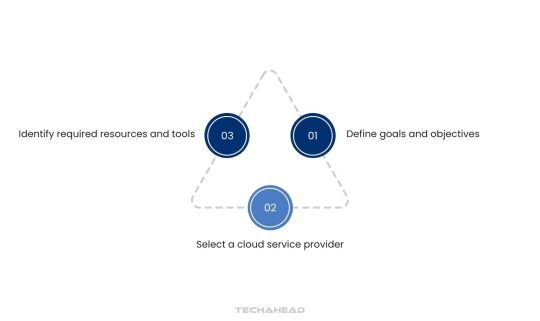
The planning phase involves creating a structured roadmap for the migration process, ensuring alignment with business objectives.
Define goals and objectives: Establish specific goals like cost reduction, scalability improvement, or enhanced security. This clarity drives project focus.
Select a cloud service provider: Choose a provider that matches your organization’s priorities. Evaluate cost, performance, security, and customer support before finalizing.
Identify required resources and tools: Determine essential resources such as migration tools, management software development, and skilled personnel to execute the project effectively.
Migrate
Migration focuses on the actual transfer of IT infrastructure, applications, and data to the cloud.
Configure and deploy cloud resources: Set up virtual machines, storage, and networking components to create a robust cloud environment for workloads.
Migrate data securely: Use data migration tools or replication techniques to ensure secure and accurate data transfer with minimal disruptions.
Test applications in the cloud: Run performance tests to verify that applications meet operational requirements. Address issues before full-scale deployment.
Operate
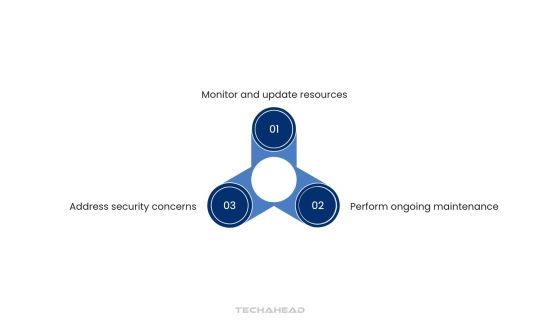
The operation phase emphasizes managing and maintaining the cloud environment for optimal performance.
Monitor and update resources: Continuously monitor cloud infrastructure to identify bottlenecks and ensure resources align with evolving organizational needs.
Perform ongoing maintenance: Proactively resolve infrastructure or application issues to prevent service interruptions and maintain system integrity.
Address security concerns: Implement robust security measures, including encryption, access controls, and regular log reviews, to safeguard data and applications.
Optimize
Optimization ensures that cloud resources are fine-tuned for maximum performance and cost efficiency.
Monitor performance metrics: Use advanced monitoring tools to track application performance and identify improvement opportunities in real time.
Adjust and fine-tune resources: Scale resources dynamically based on demand to maintain performance without unnecessary cost overheads.
Leverage cost-saving features: Use provider offerings like auto-scaling, reserved instances, and spot instances to minimize operational costs while maintaining quality.
By thoroughly understanding and executing each phase of cloud transformation, organizations can achieve a seamless transition to a modern, efficient cloud environment. This structured approach ensures scalability, performance, and long-term success.
Conclusion
Cloud migration is a multifaceted process that demands in-depth analysis of existing challenges and aligning them with strategic changes to meet business objectives. Selecting the right migration strategy depends on workload complexities, associated costs, and potential disruption to current systems. Each organization must evaluate these factors to ensure a smooth transition while minimizing impact.
While the benefits of a well-planned migration are significant, organizations must address the ongoing risks and effort required for maintenance. Ensuring compatibility and performance in the cloud environment demands continuous oversight and optimization.
For a deeper understanding of how TechAhead can streamline your cloud migration journey, explore our comprehensive guide on migrating enterprise workloads. Our cloud migration case studies also provide insights into the transformative advantages of moving critical business operations to the cloud. Partnering with experts ensures a seamless transition, unlocking agility, scalability, and innovation for your business.
Source URL: https://www.techaheadcorp.com/blog/aws-cloud-migration-benefits-strategies-and-phases-simplified/
#AWS Cloud Services#Cloud Transformation#AWS Cloud Migration#Lift and Shift Cloud Migration#Cloud Migration Strategies
0 notes
Text
Unlocking Business Potential with AWS Cloud Migration Services

AWS Cloud Migration Services | Goognu
in today’s fast-paced digital world, businesses face relentless competition and rapidly changing market dynamics. To stay ahead, organizations must be innovative, efficient, and adaptive. Enter AWS Cloud Migration Services — the ultimate solution for businesses aiming to scale, optimize costs, and leverage cutting-edge technology for sustainable growth.
Amazon Web Services (AWS) has established itself as a trusted leader in cloud computing, offering a comprehensive suite of tools and services. From computing power to storage solutions, AWS facilitates a seamless transition to the cloud, ensuring businesses can operate with flexibility and efficiency. With a robust infrastructure, businesses gain access to advanced cloud-based services, such as machine learning, data analytics, and scalable storage. These capabilities make AWS Cloud Migration Services a cornerstone for businesses seeking operational excellence and digital transformation.
Understanding AWS Cloud Migration Services
AWS Cloud Migration Services empower businesses to migrate their data, applications, and workloads to the cloud. This transition is not merely a technological upgrade but a strategic move to unlock growth and innovation. By adopting AWS, organizations can harness the flexibility to scale resources up or down based on demand, ensuring cost efficiency and optimal performance.
One of the key advantages of AWS is its ability to support serverless architectures. By moving away from traditional server-based models, businesses can streamline operations and enhance scalability. AWS’s serverless computing solutions enable organizations to focus on innovation without worrying about infrastructure management.
AWS migration services adopt a holistic approach, starting with a detailed analysis of existing frameworks and workloads. This enables businesses to identify pain points and create a tailored roadmap for a smooth migration. With AWS’s expertise, tools, and resources, organizations can navigate the complexities of cloud migration with confidence, unlocking reliable opportunities for success.
Why Businesses Need AWS Cloud Migration Services
In a world driven by digitalization, businesses are increasingly turning to cloud computing to maintain a competitive edge. Here are some compelling reasons to embrace AWS Cloud Migration Services:
1. Scalability and Flexibility
AWS provides unparalleled scalability, allowing businesses to adjust resources based on demand. Whether scaling up during peak seasons or scaling down during quieter periods, AWS ensures seamless operations. This elasticity helps organizations respond swiftly to changing market conditions.
2. Cost Efficiency
One of the most significant benefits of AWS is its pay-as-you-go model. Businesses only pay for the resources they use, leading to substantial cost savings. This approach enables organizations to optimize their IT spending and reduce operational costs without compromising performance.
3. Enhanced Security
AWS prioritizes security, offering robust measures to protect data, applications, and workloads. By migrating to AWS, businesses can take advantage of advanced security features, ensuring the safety and integrity of their data.
4. Innovation and Growth
AWS’s cloud migration services facilitate the adoption of innovative technologies, such as machine learning and data analytics. These tools empower businesses to gain valuable insights, improve decision-making, and drive growth.
5. Expert Guidance
AWS migration experts play a crucial role in guiding businesses through complex challenges. From assessing IT infrastructure to creating customized migration strategies, these experts ensure a smooth transition to the cloud.
The Role of Goognu in AWS Cloud Migration Services
When it comes to leveraging AWS Cloud Migration Services, Goognu stands out as a trusted partner. With over 13 years of industry experience, Goognu specializes in tailoring AWS solutions to meet the unique needs of businesses. Here’s how Goognu elevates the cloud migration experience:
1. Comprehensive Assessments
Goognu begins with a thorough analysis of an organization’s IT infrastructure. This assessment identifies existing challenges and opportunities, paving the way for a well-defined migration roadmap.
2. End-to-End Support
From initial planning to implementation and ongoing management, Goognu offers end-to-end support. Whether migrating legacy applications or modernizing cloud architecture, Goognu ensures a seamless journey.
3. Customized Solutions
Understanding that every business is unique, Goognu delivers tailored solutions. These include data migration services, infrastructure modernization, and enhanced optimization strategies to drive efficiency and growth.
4. 24/7 Assistance
Goognu’s round-the-clock support ensures businesses are never alone. With reliable assistance available at all times, organizations can address concerns and maintain uninterrupted operations.
Key Features of AWS Cloud Migration Services by Goognu
1. Uplifted Innovation
AWS supports a range of business practices that drive expansion and improvement. By fostering innovation, AWS enables organizations to stay ahead of the curve.
2. Worldwide Recognition and Reach
AWS’s global infrastructure allows businesses to reach a broader audience. This worldwide reach maximizes investments and opens new growth opportunities.
3. Operational Efficiency
AWS simplifies operational tasks, reducing administrative burdens. By enabling seamless interactions, businesses can focus on strategic priorities.
4. Data Analytics and Insights
With AWS’s advanced analytics tools, organizations can gain actionable insights from their data. These insights support informed decision-making and drive better business outcomes.
Benefits of AWS Cloud Migration Services
Improved Performance
AWS ensures high performance through its robust infrastructure and scalable resources. Businesses can achieve consistent performance even during peak demand periods.
Reduced Downtime
AWS’s reliable migration process minimizes downtime, ensuring a smooth transition with minimal disruption to operations.
Greater Agility
By leveraging AWS, businesses can quickly adapt to changing market dynamics and seize new opportunities. This agility is crucial for staying competitive in today’s fast-paced environment.
Enhanced Collaboration
AWS’s cloud-based solutions enable teams to collaborate more effectively, fostering innovation and improving productivity.
Why Choose Goognu for AWS Cloud Migration Services?
1. Proven Expertise
With over 13 years of experience, Goognu brings unmatched expertise in AWS consulting. Their seasoned professionals understand the intricacies of cloud migration, ensuring successful outcomes.
2. Focus on Security
Goognu prioritizes data security, offering solutions that safeguard sensitive information and maintain compliance with industry standards.
3. Cost-Effective Solutions
By optimizing IT spending, Goognu helps businesses reduce costs while maximizing the value of their cloud investments.
4. Reliable Support
Goognu’s 24/7 support ensures businesses always have access to assistance, helping them navigate challenges and achieve their goals.
Conclusion
In an era where digital transformation is imperative, AWS Cloud Migration Services offer businesses the tools and resources they need to thrive. By partnering with Goognu, organizations can harness the full potential of AWS, driving innovation, growth, and efficiency. Whether it’s optimizing costs, improving security, or embracing advanced technologies, AWS and Goognu together pave the way for a successful cloud journey.
Ready to embark on your cloud migration journey? Connect with Goognu today and unlock the true potential of your business with AWS Cloud Migration Services.
0 notes
Text
Explore the benefits of automated cloud migration, cost savings, and error reduction. Learn about key tools and best practices for a smooth transition. Assess if automation suits your business for hassle-free cloud transformation.
#Cloud Migration Service#cloud migration AWS#Cloud Automation#Cloud Migration Strategies#Cloud consulting services
1 note
·
View note
Text

Best Software Development Company | AllCode
Discover why we are recognized as the Best Software Development Company in the industry! With a proven track record of delivering innovative, scalable, and tailored software solutions, we help businesses streamline processes and achieve their goals. From web and mobile app development to enterprise-grade software, our team of experts ensures top-notch quality and timely delivery. Explore our portfolio and let us bring your vision to life with cutting-edge technology and unparalleled expertise.
0 notes
Text

Increase productivity, reduce errors, and maximize ROI with ITTStar’s DevOps solutions. We help financial firms streamline workflows, minimize downtime, and accelerate software delivery—all while maintaining the highest quality standards. Let us help you achieve operational excellence and stay ahead of the competition. Get in touch today to see how we can drive efficiency in your organization.
#devops#devsecops#cloud services#cloud migration#genai#aws services#automationsolutions#businessgrowth#continuousdelivery#maximizeroi#cloudsolutions
0 notes
Text
AWS Cloud Migration Services
Leverage our AWS Cloud Migration Services to evaluate and migrate your applications. Our expert team ensures a seamless transition with minimal risk and cost.
0 notes
Text
AWS Cloud Managed Services: Market Size, Growth, and Forecast for 2030
In today’s rapidly evolving cloud ecosystem, businesses are increasingly relying on cloud service providers to streamline operations, reduce costs, and enhance scalability. Amazon Web Services (AWS), the dominant player in the cloud services market, has emerged as a leader not only in infrastructure services but also in managed services. AWS Managed Services (AMS) offer a suite of solutions that help organizations offload day-to-day infrastructure management tasks while optimizing their cloud environment for performance, security, and cost-efficiency.
As enterprises continue to migrate to the cloud, the demand for AWS Managed Services is expected to grow significantly. In this blog, we will delve into the market size, growth trajectory, and forecast for AWS Managed Services leading up to 2030.

What Are AWS Cloud Managed Services?
AWS Managed Services (AMS) are designed to help businesses monitor, manage, and optimize their AWS cloud environments with minimal effort and resources. These services typically cover infrastructure management, security, incident response, backup, patch management, and system monitoring. AMS is ideal for organizations that want to leverage the full potential of AWS without dedicating substantial internal resources to manage these complex tasks.
Key Features of AWS Cloud Managed Services:
24/7 Monitoring and Support: AMS offers round-the-clock monitoring and management of cloud infrastructure to ensure optimal performance.
Security and Compliance: With built-in security features, including vulnerability scanning, patch management, and compliance reporting, AWS helps businesses stay secure and compliant.
Cost Optimization: AMS helps businesses monitor and manage their cloud spending with intelligent resource management and right-sizing.
Scalability and Flexibility: AWS’s managed services scale as your business grows, ensuring you have the right resources at the right time.
The Growing Demand for AWS Cloud Managed Services
The increasing complexity of managing cloud environments is a driving force behind the rapid adoption of managed services. More organizations are shifting to the cloud to take advantage of its scalability, flexibility, and cost-effectiveness. However, cloud environments also present unique challenges related to management, security, compliance, and performance optimization. For many organizations, especially those without specialized cloud expertise, outsourcing the management of these environments to a third party like AWS is a logical choice.
Key factors driving the demand for AWS Managed Services include:
Cloud Migration and Adoption: As businesses continue to migrate to AWS, the need for managed services is rising. AWS offers robust managed services tailored for enterprises, making it easier for organizations to transition from on-premises infrastructures to the cloud.
Cost Control and Efficiency: Managing and optimizing costs is one of the biggest challenges for businesses using the cloud. AWS Managed Services offer businesses the tools and expertise to control cloud spending, ensuring resources are used efficiently.
Security and Compliance Needs: Security is a major concern for businesses operating in the cloud. AWS Managed Services help organizations meet regulatory requirements and adhere to best practices for security and compliance.
Focus on Core Business: By outsourcing cloud management to AWS, organizations can focus on their core competencies rather than spend time and resources managing IT infrastructure.
Growing Complexity of Cloud Environments: As businesses expand their use of cloud-native technologies (like Kubernetes, serverless computing, and machine learning), managing these complex environments becomes more challenging. AWS Managed Services provide the expertise to optimize and support these advanced cloud environments.
Market Size and Growth of AWS Managed Services
The global market for cloud-managed services is rapidly expanding. According to a 2023 report by Grand View Research, the global cloud managed services market was valued at approximately $47.76 billion in 2022 and is projected to grow at a compound annual growth rate (CAGR) of 12.3% from 2023 to 2030. The growth is being fueled by the widespread adoption of cloud technologies, the shift to hybrid cloud models, and the growing need for IT cost optimization.
While the overall managed services market includes services from other providers like Microsoft Azure, Google Cloud, and IBM, AWS commands a significant share of this market due to its dominant position in the cloud industry.
Current Market Share of AWS Managed Services: AWS continues to be a market leader in the cloud services space, holding a dominant share of the cloud infrastructure market, which is estimated to be around 33% as of 2024, according to Synergy Research Group. With this strong position in the overall cloud market, AWS is well-positioned to capture a large portion of the managed services market as well.
Growth Trajectory: The demand for AWS Managed Services is expected to grow in line with the broader cloud services market. By 2030, the AWS Managed Services market is anticipated to be worth $30-$35 billion globally. This growth is underpinned by the expansion of digital transformation initiatives and the increasing reliance on cloud-native services.
Regional Growth: North America and Europe currently dominate the AWS Managed Services market due to their high cloud adoption rates and the presence of many large enterprises. However, the Asia-Pacific region is expected to witness the highest growth rate in the coming years, driven by increasing digitalization in countries like China, India, Japan, and South Korea.
Key Drivers for Growth Toward 2030
Cloud-Native Technologies and Automation: AWS is continuously innovating with services like AWS Lambda (serverless computing), Amazon ECS (Elastic Container Service), and Amazon EKS (Elastic Kubernetes Service). As more organizations adopt cloud-native technologies, the need for specialized management services will increase, benefiting AWS Managed Services.
Artificial Intelligence (AI) and Machine Learning (ML): AI and ML technologies are becoming more accessible through AWS Managed Services. AWS offers tools like Amazon SageMaker and other ML services that can be managed through AMS, reducing the complexity of these advanced technologies and making them accessible to businesses of all sizes.
Security and Regulatory Requirements: With increasing regulatory scrutiny around data privacy (GDPR, CCPA) and security concerns, AWS Managed Services will play a critical role in helping businesses meet their compliance and security obligations.
Expansion of Hybrid and Multi-Cloud Environments: Many businesses are adopting hybrid cloud or multi-cloud strategies, incorporating AWS alongside other cloud providers like Azure and Google Cloud. AWS Managed Services can help businesses manage these complex environments, fostering growth in AMS adoption.
Automation and AI-Driven Operations: As AWS continues to integrate artificial intelligence and automation into its managed services offerings, businesses can benefit from more efficient operations, enhanced security, and faster incident response times.
AWS Managed Services Market Forecast for 2030
Looking ahead to 2030, the AWS Managed Services market is poised for exponential growth, driven by the following key trends:
Cloud Maturity and Integration: By 2030, cloud environments will be more integrated and automated, with AI-driven systems providing intelligent operations. AWS will be at the forefront of this evolution, offering managed services that not only monitor infrastructure but also proactively optimize performance and cost.
Smaller Enterprises Adopting Managed Services: With the increasing affordability of AWS services and more tailored solutions, small and medium-sized enterprises (SMEs) will also increasingly adopt AWS Cloud Managed Services, contributing to market growth.
Expansion into Emerging Markets: AWS is likely to expand its presence in emerging markets like Latin America, Southeast Asia, and Africa, where the adoption of cloud services is accelerating. These regions will see substantial growth in demand for managed services, with AWS playing a key role.
Conclusion
AWS Managed Services are at the heart of a transformative shift in the cloud industry. As businesses face increasing complexity in managing their cloud infrastructures, the demand for AWS’s expertise and services will only grow. By 2030, the AWS Managed Services market is expected to be a multi-billion-dollar industry, driven by the need for optimized cloud environments, enhanced security, cost efficiency, and access to cutting-edge technologies like AI and machine learning.
For businesses looking to take advantage of the cloud while minimizing the complexities of management, AWS Managed Services offer a comprehensive, scalable, and cost-effective solution. With AWS continuing to innovate and expand its offerings, the future of managed services looks promising, with the potential to reshape the cloud landscape for the coming decade.
#AWS Managed Services#AWS Cloud Managed Services#aws cloud services#cloud migration companies#cloud solutions#cloud service provider#cloud services
0 notes